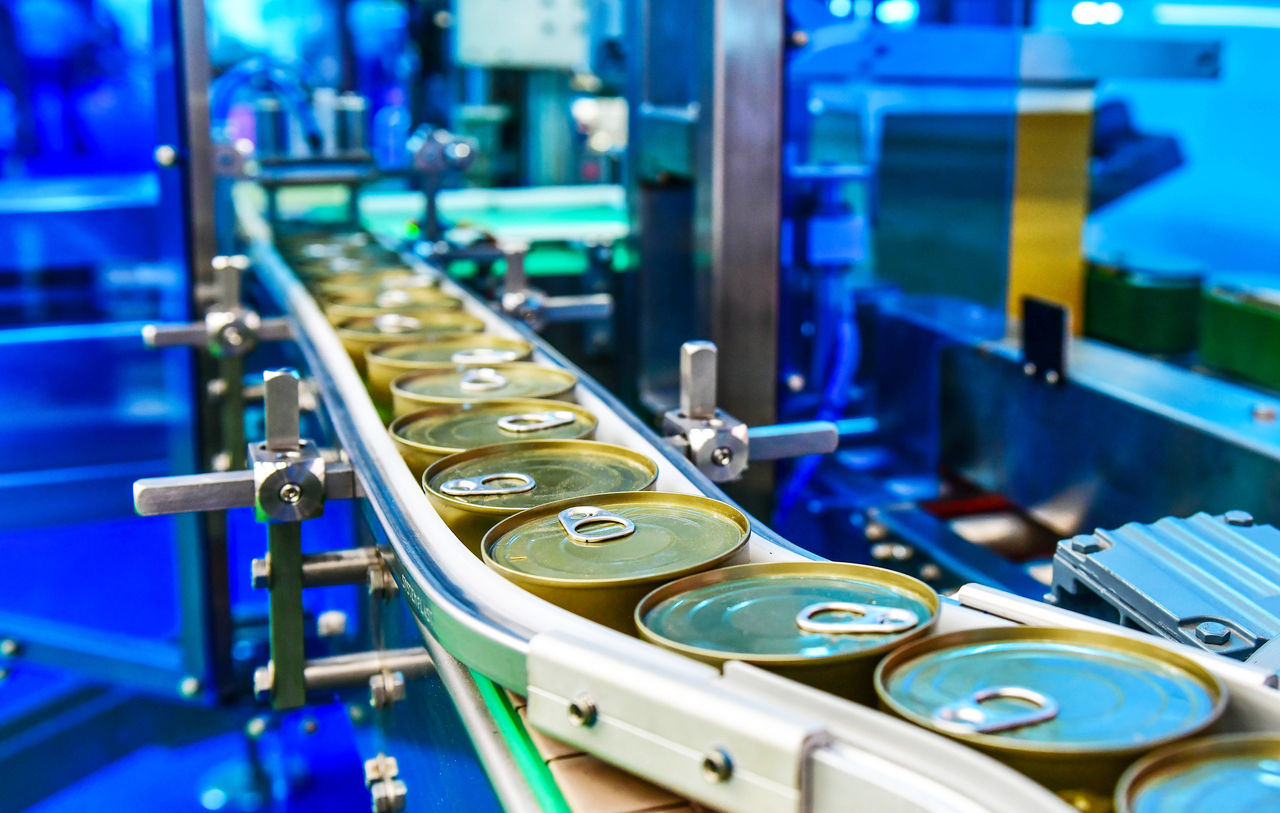In this article
Understanding H1 Fluids and Food Safety: An Expert Guide

Picture the fast-paced environment of a food manufacturing plant. Food items are being processed at high speed and amid all this activity, an unforeseen incident occurs: a tiny droplet of lubricant from one of the machines splashes onto a food item. You might ask, “What’s the acceptable limit for such contact?”
Food safety guidelines provide a clear benchmark. The ‘incidental contact’ under food safety standards is limited to 10 parts per million (ppm). Visualize a large container with a million peas. Only 10 of these peas, or a minuscule 0.001 percent, could be in contact with the lubricant and still meet the safety threshold. That’s less than half a teaspoon in a 200-litre drum!
This scenario shows the importance of rigorous food safety standards, with particular attention to the critical role of food-grade fluids and oils when the possibility of food contact emerges. Vincent Meijer, Product Category Manager at ERIKS, stresses that it’s essential to understand the specific needs of each application when selecting the most appropriate lubricant. We had an insightful conversation with him to delve into the rigorous food safety norms while also addressing and dispelling some of the main misconceptions in the field.
Range of applications in the food industry
The food industry encompasses many applications where technical fluids, such as lubricants, cleaning agents and coatings, for instance, are essential for smooth machinery operation. These can include conveyor belts, gears, mixers, pumps, slicers and various other types of equipment. Vincent Meijer explains, “It’s important to analyse each situation thoroughly: what is the current use of a particular lubricant, in which application, and what is the environment like? These factors together determine the requirements that must be met.” Each application has unique demands and challenges, such as different types of motion, load requirements and exposure to specific substances, and more, which we will review below.
Focus on H1 lubricants
In the food industry, lubricants must meet strict regulatory standards to prevent contamination and ensure the integrity of the end products.
H1 lubricants are specifically formulated to be food-grade, which is safe for incidental contact with food products. The formulation of H1 lubricants considers the potential risks associated with direct or indirect contact with food, prioritizing the prevention of contamination. This includes being non-toxic, non-allergenic and resistant to degradation or breakdown that could compromise food safety.
Incidental contact, as it relates to H1 lubricants, refers to unintended or occasional contact with food products during the food processing cycle.
In real-world situations, the possibility of incidental contact can never be entirely ruled out. For example, a small leak or a drop of lubricant might splash onto a food item. In these scenarios, using H1 lubricants ensures that the safety of the food is not compromised if the contact occurs within the permitted 10 ppm rule (for silicones only up to 1 ppm.)
It’s important to understand that using H1 lubricants is not a substitute for good manufacturing practices. Instead, these lubricants are part of a comprehensive approach to food safety that includes proper equipment maintenance, regular cleaning and sanitation and strict adherence to food safety guidelines and regulations.
Similarly, when using halal-certified lubricants, for instance, it does not automatically make the entire environment halal. Additional measures, such as proper cleaning and hygiene, must be implemented to maintain a halal environment throughout the food processing operations.
Determining appropriate lubricant certification
It’s natural to rely on certifications as markers of quality and safety. However, as Vincent asserts, digging deeper and truly comprehending what these certifications entail is essential. Having the NSF mark alone doesn’t certify a lubricant as food-grade. Only the H1 grade within this certification ensures compliance with food safety regulations.
“This is often misused because people are familiar with the term 'certification' but do not fully understand what it means. Of all the certified products, only one kind is allowed to have incidental, direct contact with food. And that is H1. This is essential to remember,” Vincent explains, “I always stress to everyone: this is the only product that is allowed to have incidental contact with food. The rest are not allowed.”
A Step-by-step Approach for Assessing Customer Requirements
“Our approach starts with gaining an in-depth understanding of the situation. Based on this insight, we can identify the right solution. We call this ‘solution selling,” It is also important to truly understand the customer’s expectations to be able to meet them. Otherwise, you might achieve certain improvements, but the customer’s goal has not yet been achieved. A step-by-step approach can help ensure comprehensive evaluation and tailored solutions when assessing a customer’s needs. The following steps outline this approach:
Focusing on one section of the factory at a time for thorough evaluation:
It is advisable to concentrate on one area or machine at a time to ensure a detailed assessment. This approach provides a comprehensive understanding of that specific section’s unique challenges and lubrication needs.
A thorough machinery inspection is conducted to identify potential sources of problems or inefficiencies. Vincent explains, “I often ask: why are you considering a change? Why are you considering a different lubricant? Is the current product not performing well? An expensive new lubricant is not always the solution. Perhaps the cause of the problem is that the tanks are overloaded. It is important to consider the different aspects within a factory or food environment.”
Considering temperature fluctuations, exposure to powder or dust and resistance to liquids
Temperature fluctuations, powder or dust and resistance to liquids are critical factors in lubricant selection. Evaluating the temperature range within the application area helps determine the lubricant’s ability to maintain its viscosity and performance under specific thermal conditions. Vincent: “For example, a conveyor belt can be exposed to high temperatures, but the same belt can also be used in a freezer. In the latter case, I need a lubricant that does not thicken too much at low temperatures.”
Understanding the exposure to powder or dust helps identify oils with appropriate additives or properties to prevent contamination or degradation. Vincent: “Take a bakery, for example. The combination of sugar, water and heat can be disastrous for lubricants and chains. Some specific products prevent a coating from forming, safely remove excess sugar and prevent caking. The same applies to many industrial processes.”
Additionally, assessing the resistance to liquids, such as acids or cleaning agents used in the production process, ensures the lubricant can withstand potential chemical interactions.
Evaluating static and dynamic forces, rotational movement
Different machinery in the food production environment experiences varying levels of static and dynamic forces and rotational movement. Understanding these factors aids in selecting lubricants with suitable viscosities and load-carrying capacities. Additionally, assessing water resistance is crucial, especially in applications where water is present or there is a risk of contact. Lubricants with effective water resistance properties help prevent damage and maintain proper lubrication even in wet environments.
Measuring and Sampling
Measuring oil samples allows for identifying any issues, such as contamination. “By analyzing the oil samples, we can assess the condition of the lubrication system, detect the presence of contaminants like particles or water and determine their impact on the lubricant’s performance," Vincent explains. "This information is essential for diagnosing problems and recommending appropriate solutions.”
Process Improvement & Training
In addition to lubrication-specific recommendations, ERIKS offers holistic suggestions to optimize overall equipment performance. This may involve process improvements, such as workflow adjustments to enhance productivity. ERIKS may recommend equipment upgrades or replacements if there are outdated or damaged components that no longer meet operational requirements. Furthermore, ERIKS can provide training programs or workshops on best practices for machine operation and maintenance.
Vincent: “It's important to understand that over-lubrication can damage the bearing. Sometimes the solution is not a better product but a better understanding and use of the current product. This is why I suggested training employees on how to lubricate bearings correctly. By learning why a bearing should be lubricated in a specific way, we can increase our machines’ effectiveness and service life.”
Need for proper cleaning
Vincent: “It is a common misconception that food-grade lubricants (the ‘white’ products) are of lower quality than conventional lubricants (the ‘brown’ products). This dates back to a time when this could be the case. However, today the quality of food-safe lubricants is as good as that of conventional lubricants. However, randomly switching between the two types of lubricants in a factory can be risky.”
If you're operating with separate zones for white and brown lubricants, remember that contamination can occur through movement between sections of the plant, through the shoes, for example.
Transitions between different agents or lubricants also pose a particular challenge. During these transitions, it’s essential to carry out detailed cleaning and flushing procedures to prevent cross-contamination.
Vincent: “When switching from one type of lubricant to another, it is important to clean the equipment properly. For example, when changing the oil in a gearbox, it should be properly flushed. Careless cleaning can lead to contamination of the new oil. This is because new oil has the property of cleaning very thoroughly. It can dissolve old, stuck contaminants that then get into the oil. After the first change, the oil may therefore appear dirty, when in fact, this is a sign that the oil is doing its job. It is therefore always important to clean as thoroughly as possible during a change.”
Preferred brands and attention to product quality
At ERIKS, we value the collaboration with leading brands and prioritize quality above all. Our partnerships ensure we provide lubricants that consistently meet the highest safety standards within the food industry. Recognizing that each situation is unique, our team is always prepared to deliver customized solutions aligned to your specific needs.
If you’re interested in implementing a Fluid & Oil Management program and for any additional inquiries, feel free to contact us at ERIKS. Our dedicated team is committed to understanding and addressing your specific requirements. We look forward to supporting you in your operational objectives while upholding the most stringent food safety standards.
For more information on Lubrication Solutions and to get in touch with Amy Jasper, UK Lubrication Specialist or please contact your local ERIKS Service Centre, who will be happy to discuss your options.
#ERIKS #LetsMakeIndustryWorkBetter #Lubrication

